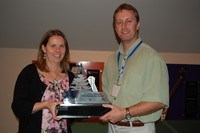Vale Inco has reason to be proud of the engineered multi-layer cover design system used to reclaim its open-pit Whistle Mine 60 kilometres northeast of Sudbury.
“This is probably one of the first (reclamation projects of this kind) that was well-designed upfront. No one has done it to this extent,” said Lisa Lanteigne, Vale Inco’s senior environmental specialist.
The reclamation work at the Whistle Mine earned Vale Inco the Tom Peters Memorial Mine Reclamation Award at the second annual Ontario Land Reclamation Symposium hosted by the Canadian Land Reclamation Association (CLRA) and Ontario Mining Association (OMA) in Timmins June 9 and 10.
Now in its second year, the fledgling award was named after Tom Peters, a recognized leader in land reclamation and founding member of the Canadian Land Reclamation Association, established in 1975. Peters was a well known agriculturist for Inco Limited from 1948 to 1985. He pioneered the use of agricultural practices for re-greening mine tailings, many of which became the standard practice for mines all over the world.
“Two nominations were deemed to meet the requirements of the award,” said CLRA president Bryan Tisch. “Both were excellent and represented the quality work that we want to associate with the Tom Peters Award.”
Waste rock
The Whistle Mine’s history dates back to 1897 when its nickel/copper orebody was discovered. The mine was only developed in 1988 and operated intermittently for a total of seven years until 1998. During that time, seven million tonnes of waste rock was removed and stored on site in two large stockpiles above the open pit.
The pit covered an area of 9.7 hectares and is situated in an environmentally sensitive area within the Post Creek watershed, a system that drains into Lake Wahnapitae, approximaterly three kilometres east of the site. The Wahnapitae First Nation Reserve is located downstream on Lake Wahnapitae and at the mouth of Post Creek.
Sulphide mineralization resulted in acid generating waste rock, producing seepage with low pH and high metal content. Four collection ponds were constructed around the perimeter of the site to collect both seepage and runoff from the northeast and northwest waste rock dumps. From there, the water was directed to a lime treatment plant.
An environmental study and investigation of the waste rock dumps identified complexities in the topography of the open pit and its proximity to nearby watersheds. Instead of attempting to construct a cover over the waste rock piles, geochemical modelling showed it was better to move the waste rock into the open pit and cap it with an impermeable, multilayer, engineered dry cover. The purpose of the cover is to block the influx of atmospheric oxygen and precipitation to the waste rock and thus prevent the generation of acid drainage.
“A closure plan was submitted with the basic concept to fill in the pit and cover it,” said Lanteigne. “But detailed engineering showed that the waste rock had to be placed into the pit, not dumped.”
The impact of dumping the rock from the top of the pit wall would have created too much settlement in the pit, and would have ultimately destroyed the integrity of the cover. So the waste rock was trucked down to the bottom of the pit and placed there over a three-year period, adding millions to the cost, according to Lanteigne. Day Construction received the contract for the hauling.
Lime
The waste rock was treated with approximately 11,462 tonnes of lime to help neutralize the acid.
Mike O’Kane, from O’Kane Consultants Inc., a Saskatoon dry cover specialist, was brought in to further refine the detailed engineering. He spearheaded the construction of a series of test plots to obtain information about the type of cover to be used and how to construct it.
“We modelled different cover materials, different thicknesses of materials, a certain rate of infiltration (of oxygen and water) through different materials, increase thickness...then we set up the test plots,” Lanteigne said.
Three different barrier layer materials, approximately 50 feet by 200 feet, were placed on top of a scaled waste rock pile, graded and contoured to match the topographic conditions of the pit.
Compacted sand-bentonite, compacted silt/trace clay and prefabricated Geosynthetic Clay Liner barrier layers were monitored over a two-year period for net percolation through the cover, climatic parameters, gaseous oxygen and carbon dioxide concentrations, moisture and temperature within the cover and waste materials.
Several University of Western Ontario graduate students helped collect and assess the data.
The compacted silt/trace clay material was chosen as the preferred barrier. As it turned out, Vale Inco was able to use clay previously excavated from another project on its Copper Cliff property.
Landform modelling was also used to decide on the actual contours of the land to ensure proper drainage, adequate grass cover and to reduce erosion. The objective was to develop a landform with catchments that are similar to natural systems.
“Eventually, we want to put shallow-rooted shrubs on the cover to make it a stable system,” Lanteigne said.
Sensors
There is one primary and eight secondary in situ cover monitoring sites. Sensors placed in the cover layers monitor the amount of water getting through, the moisture of the cover, temperature, oxygen, and carbon dioxide. Ground water is also being monitored.
Water from seven collection ponds is pumped to and treated in the water treatment plant before being discharged into the environment.
The project was completed in 2006 for a total cost of $19 million.
So far, everything is intact. Lanteigne said it is a dynamic system, and they are still evaluating the performance of the cover.
“It appears to be working,” she said. “There is no erosion, the surface water is of good quality and there is good sediment control.”
Ultimately, the goal is to walk away from the project, but for now, the monitoring systems will remain until performance of the pit cover system is seen to be sustainable.



